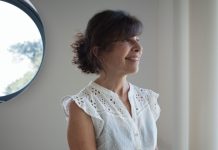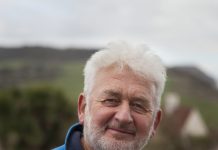Robin Mills went to meet Peter Gostelow in Godmanstone, in the Cerne Valley. Peter has spent the last three years returning from Japan, travelling through 30 countries, covering some 30,000 miles… on a bicycle. This is his story.
“I suppose when I was younger, travelling was always exciting: our family holidays often involved sailing, which could be pretty adventurous. After University I travelled alone in Africa for 8 months, using public transport. I loved it, but sometimes there was a sense of missing out on rich experiences by sitting in buses and trains as the countryside passed by.
So I returned to the UK, but I knew now I wanted to travel more. I trained as a TEFL teacher, and during this process the idea came to me of making a “big trip”, and doing it on a bicycle. Eventually I was offered a job teaching English in a Japanese school. During one of my holidays, to the complete bewilderment of my Japanese employers, I cycled round an island close to the school, about 1000 miles in 3 weeks. I found that an amazing experience, one which really confirmed that my idea might work, but the notion of actually cycling all the way to the UK was so crazy that I kept it pretty much to myself. Nobody likes to announce something like that, and then not do it.
On the face of it, planning such an expedition is impossible. I had maps plastered all over the walls of my room, and read a couple of inspiring travelogues, by German traveller Heinz Stucke, and the late Ian Hibble, an Englishman who was well-known in the cycling world. Stucke describes the simplicity of bicycle travel and how it allows the traveller to fully experience the richness of cultures and communities.
Getting visas for the countries I wanted to cross was only possible to a limited extent: I’d no idea how long it was going to take to get from a to b, so dates of entry and departure were a complete unknown. Some countries, used to western tourists, are easy: some, especially Iran and former Soviet states, need months of planning. I realised I couldn’t really make a specific planned route, with little idea of what to expect, but at a guess I thought it might last a year and a half. The equipment I took had been carefully researched, and as a keen photographer, a digital SLR camera was a vital part of it.
Leaving Japan on August 1st 2005, my first stop was South Korea, then by ferry to Eastern China. Although the most direct route from there would have been to head west across Central China, by November the weather would have been bitterly cold all the way, so I turned south and made for Southeast Asia. From then on, the weather became an important factor in deciding the route: cycling in cold or wet weather is really hard, as is camping out at night. However, I chose destinations for all sorts of reasons, but often simply because of striking landscapes, like Tibet, Western China, Pakistan: the photography motivated me, and when actually cycling I would be looking at the scenery as if through a lens. On a bike, the slow pace allowed me to see images and sometimes to go back and take the shot. Arriving in towns, I’d spend a day or more walking round, taking photos. From my maps I’d choose the smallest roads, hoping that the people who lived in the remoter places along those roads would be more excited to see a westerner on a bike, making the experience for me more interesting: fewer tourists, and more photo opportunities. Of course, despite the freedom of cycling, it’s often very limiting. Many amazing places were just too far away to get to in the time available. Sometimes I thought it would have been better on foot, especially for photography, and sometimes I wished I’d had a motorbike.
In some countries, like Thailand, where I’d been before on holiday, I never felt very far out of my comfort zone: in most places English was spoken, but in other places I could go days and weeks without hearing my own language. I had a Chinese phrase book, so that in remote China I could find food, directions and accommodation, but it was simple communication. I had lots of energy early in the trip, and I didn’t feel too isolated, just excited by the adventure. There was something about the nature of the trip which meant that the longer I went without something, the more I appreciated it when I got it – like company with other westerners, good food, or a hot shower. It did get harder for me though as the trip went on.
It’s true to say, generally, that the places with the fewest tourists are the friendliest. In Muslim countries, like Pakistan, hospitality is part of the religion. Being invited to people’s homes for food, or to stay in their house, almost made me feel a bit trapped, but I always felt incredibly indebted to them for their generosity. I can’t remember ever feeling really in danger: or if I did it was due to my misreading a situation, or some kind of prejudice lurking in my mind. Back home in the UK, with hindsight, I wonder how I actually coped with some situations, but at the time I just did. I also think back on places like Tibet, in the Himalayas, incredibly remote, where if something had happened to me there was no one to help for miles and miles. I rarely ever knew in advance where I was going to stay at night: it became a routine to just deal with situations as they arose. The trip showed me how we’ve become so security dependant in our world these days.
I headed south into India, to Delhi. My Mum flew out to meet me, and we took a trip by train to the southern tip of India. It was great to have a few weeks break from cycling. When she went home, I cycled back to Delhi, finding the diversity of culture, religion, language, and the intensity of the experience almost overwhelming. In northern India the temperature was rising, so it was time to head back into the cooler mountains – north through Pakistan towards western China. This route followed the famous Karakoram Highway, where my neck was often craning to look up at 7000m high peaks. From China, my route led across central Asia, through the former Soviet states of Kyrgyzstan, Tajikistan, Uzbekistan and Turkmenistan, whose cultures are both Muslim and Russian influenced. With a little trepidation I was now heading into Iran.
I’d avoided the heat of the Iranian summer, but my direct route home from there would have meant a European winter, so I headed south, and extended my trip through the Middle East and North Africa for several more months. I crossed back to Europe by ferry from Tunisia to Sicily, and cycled through Italy, Germany, Switzerland and France in the spring and early summer.
The homecoming in England was going to be strange. While I’d been away, my Mum had moved to Godmanstone, in Dorset: it was a home I didn’t know. But that last day, in July 2008, almost 3 years after I left Japan, I cycled from Gillingham thorough wonderful scenery, past fields misty in the early morning sun. There was a sign in Godmanstone which, though my tear-filled eyes, I read as “Pete”, and I thought this must be it: it actually said “Fete”. There was of course a huge family welcome for me round the corner.
People often ask if the trip has changed me: fundamentally I’m the same person as when I set out, but I do think I’m more open-minded. I accept things for what they are now, having had all these experiences. Over the coming months I’m interested in giving talks/slideshows to schools, clubs and organisations about the trip, as well as planning my next adventure. If anyone wants to get in contact my website is www.petergostelow.com.”









